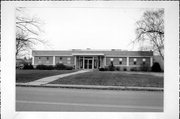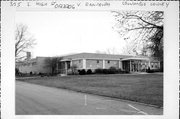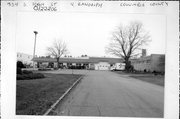Property Record
335 S HIGH ST
Architecture and History Inventory
| Historic Name: | J.W. Jung Seed Co. |
|---|---|
| Other Name: | J.W. Jung Seed Co. |
| Contributing: | |
| Reference Number: | 122206 |
| Location (Address): | 335 S HIGH ST |
|---|---|
| County: | Columbia |
| City: | Randolph |
| Township/Village: | |
| Unincorporated Community: | |
| Town: | |
| Range: | |
| Direction: | |
| Section: | |
| Quarter Section: | |
| Quarter/Quarter Section: |
| Year Built: | 1951 |
|---|---|
| Additions: | |
| Survey Date: | 2001 |
| Historic Use: | small office building |
| Architectural Style: | Art/Streamline Moderne |
| Structural System: | Masonry |
| Wall Material: | Brick |
| Architect: | W. Fred Dolke |
| Other Buildings On Site: | |
| Demolished?: | No |
| Demolished Date: |
| National/State Register Listing Name: | Not listed |
|---|---|
| National Register Listing Date: | |
| State Register Listing Date: |
| Additional Information: | A 'site file' exists for this property. It contains additional information such as correspondence, newspaper clippings, or historical information. It is a public record and may be viewed in person at the Wisconsin Historical Society, Division of Historic Preservation. November 2001-The J. W. Jung Seed Company Building is a one-story structure finished with cream brick and set on a concrete slab foundation. The building was designed by Chicago architect W. Fred Dolke and erected in 1951. The front one-third of the building, which housed the company's offices, is Art Moderne in style. The rear two-thirds is astylistic utilitarian in appearance and was occupied by shipping and catalog-printing originally. A c. 1970, one-story, concrete block addition projects from the rear of the building. In the front section, a narrow parapet, capped with a white stone coping, hides the flat roof. The entrance is centered on the east-facing (front) facade and is composed of a pair of glass-and-metal doors, framed by glass sidelights and transoms and protected by a flat-roofed metal canopy on slender posts. On top of the canopy, metal letters spell out "J.W. JUNG SEED CO." Fluted pilasters of white stone separate four bands of glass block windows on the front facade; the windows wrap around the sides of the building. Pairs of small, square windows are set within the glass block. This may be the original configuration; a 1970 photo shows the windows as they currently are. Continuous lintels and sills of white stone enhance the streamlined appearance of the front section of the building. The rear section displays bands of small, 1/1 windows. Statement of Significance: John W. Jung was fascinated with seeds from a young age. Jung went to business school in Oshkosh and apprenticed with H. W. Buckbee of Rockford, Illinois before starting the J. W. Jung Seed Company in 1907. Jung grew garden and farm seeds on his family's farm in Courtland Township and sold them by mail-order, printing 400 catalogs on a toy press that first year. For the first several years, business was slow and Jung had to hire himself out during threshing season to make ends meet. To help promote his business, Jung wrote articles on gardening for agricultural magazines in exchange for free advertising. Jung persisted and in 1910, his company began taking off. Some 10,000 catalogs were printed that year. Jung had a seed house built on his family's farm the same year. In 1913, Jung relocated his business to the village of Randolph, where he operated a series of structures until acquiring Alton Hall at 115 East Stroud in 1919. The Jung Seed Company remodeled and added onto that building, occupying until it was destroyed by fire from a lighting strike on 1 June 1951. The existing building was erected immediately thereafter, and was dedicated 9 February 1952. The J. W. Jung Seed Company expanded its mail-order business throughout the twentieth century. In 1935, over 280,000 catalogs were mailed, going to every state and several foreign countries. In 1970, this figure exceeded 500,000. The Jung Seed Company added nursery stock in 1922, developed hybrid corn in 1934, Vicland oats in 1941, and established a certified seed grain program shortly thereafter. Over time, the Jung Seed Company has also acquired land outside of Randolph on which to grow the seeds, plants, shrubs and bulbs that it sells. In 1970, the company owned more than 900 acres. In addition, the firm obtains some of its seeds and plants from growers in other states and other countries. |
|---|---|
| Bibliographic References: |
| Wisconsin Architecture and History Inventory, State Historic Preservation Office, Wisconsin Historical Society, Madison, Wisconsin |



